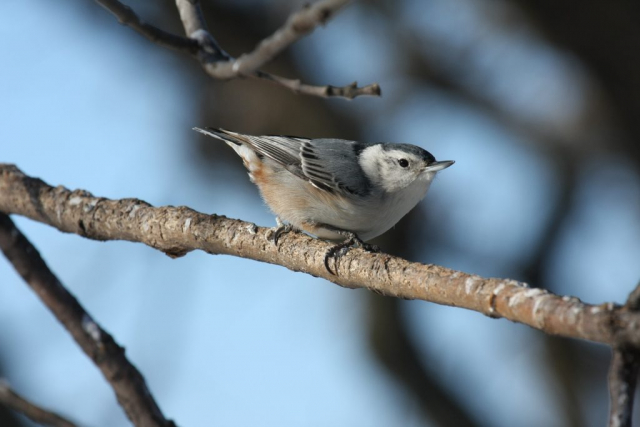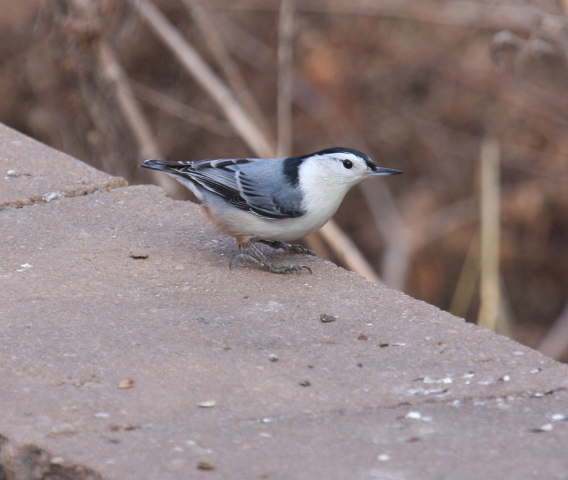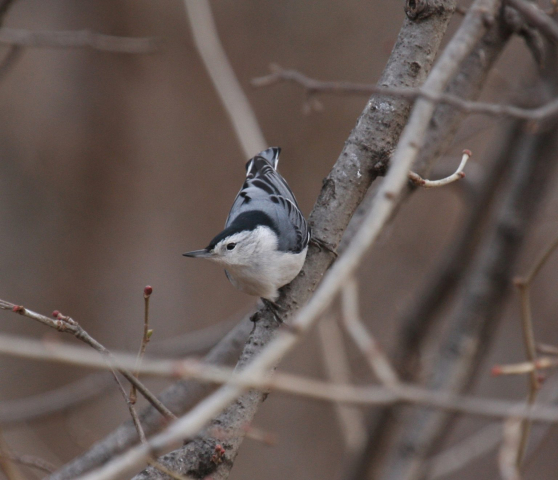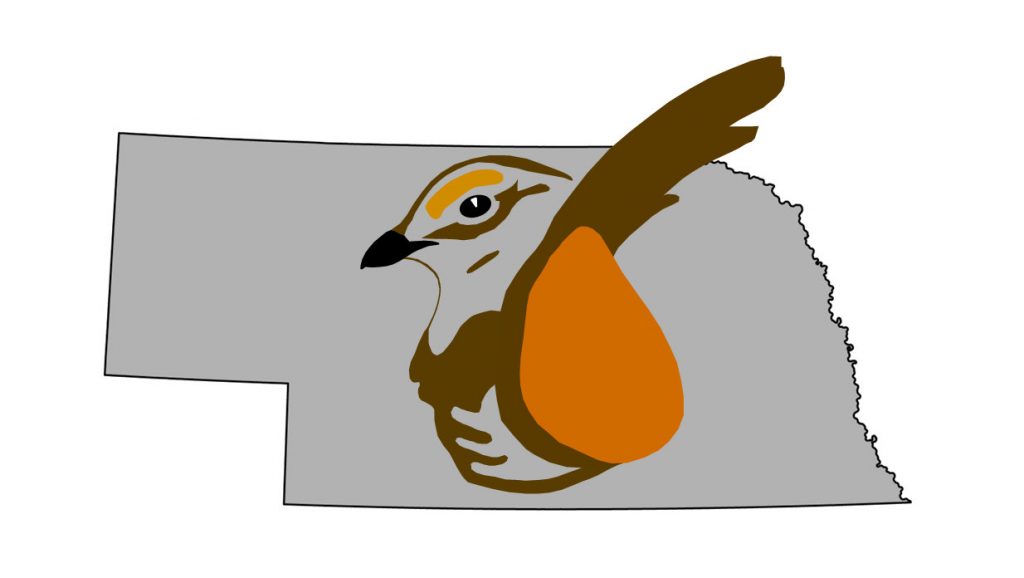Sitta carolinensis carolinensis, S. c. nelsoni
Status: Common regular resident east, central, and northwest. Uncommon regular winter visitor statewide.
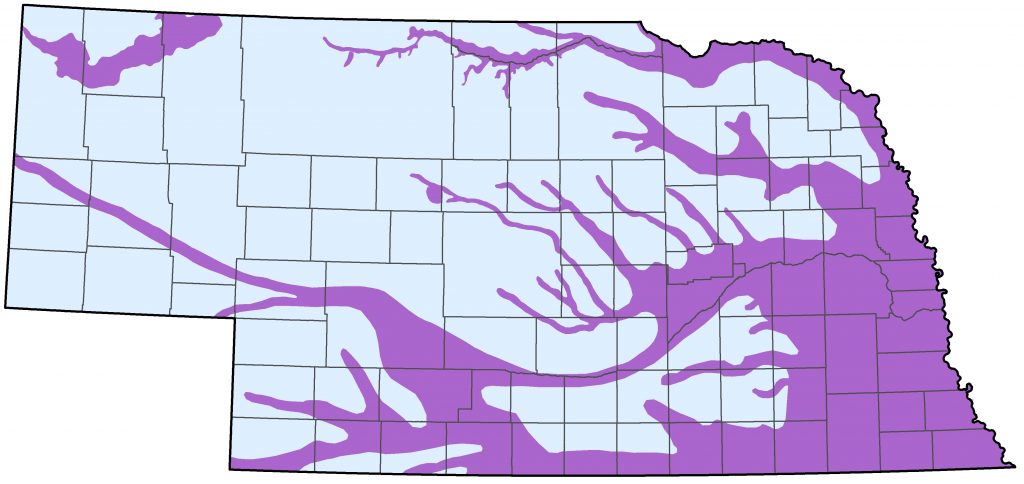
Documentation: Specimens: carolinensis: UNSM ZM11608, 23 Mar 1895 Lancaster Co; nelsoni: UNSM ZM6557, 14 Jun 1901 Warbonnet Canyon, Sioux Co.
Taxonomy: Gill et al (2022) recognized seven subspecies, three of which occur in Mexico; the others are: aculeata of coastal southwest British Columbia to southwest California, tenuissima of southeast British Columbia to western Wyoming, wintering to New Mexico and Kansas, nelsoni (including oberholseri) from Montana to Arizona east to eastern Wyoming, southwest South Dakota, and northwestern Nebraska, south to western Oklahoma and western Texas, and carolinensis (including cookei) from Saskatchewan and southeast Texas to New Brunswick and Florida.
Northern birds within the range of carolinensis have been assigned to cookei based on size (Phillips 1986), but recent authors merge cookei with carolinensis as their differences were considered clinal (Pyle 1997, Grubb and Pravosudov 2020).
Grubb and Pravosudov (2020) noted the division of the subspecies into three “call” groups: Eastern US and Canada birds, uttering a nasal “yenk”, Great Basin and Rocky Mountains birds a rapid “yijijijijiji”, and Pacific Slope birds a high-pitched, drawn-out “yaarn”. These call groups are genetically distinguishable (Spellman and Klicka 2007) and may in fact be three cryptic species, a position supported by a new genetic study that suggested there are three or possibly four species in the White-breasted Nuthatch complex (Askelson 2023).
In Nebraska, nelsoni of the Rocky Mountains Group breeds on the Pine Ridge, and carolinensis of the Eastern Group in riparian corridors and forests in the rest of the state (AOU 1957), including the North Platte River Valley. Pyle (1997) suggested that since movement patterns of this species are poorly known, unexpected subspecies might occur during winter. Most likely among these would be tenuissima, which winters southeastward to Kansas (Pyle 1997).
Sightings and photographs on the Pine Ridge Jun-Jul 2019 noted equivocal features suggestive of some level of introgression between nelsoni and carolinensis (Steve Mlodinow, Michael Willison, personal communications), probably as might be expected at range boundaries between subspecies; Steven Mlodinow (personal communication) has noted some “friendly” interactions between the two subspecies. Since 2019 there have been several reports of carolinensis on the Pine Ridge, most in Dawes Co at Chadron Creek Ranch WMA, Chadron SP, and Fort Robinson SP, and at dates indicating residence. A carolinensis carrying food at Chadron Creek Ranch WMA 24 Jun 2021 was thought to be the same bird seen there in winter with a nelsoni (Mlodinow, eBird.org). Elsewhere on the Pine Ridge, a carolinensis was at Sowbelly Canyon, Sioux Co 27 Jul 2023, and a likely intergrade was at Gilbert-Baker WMA, Sioux Co 22 Jan 2024. One was at Box Butte Reservoir, Dawes Co 25 Jun 2023.
Changes Since 2000: Reports have increased since 2000 west of Lake McConaughy in the North Platte River Valley as far as Scotts Bluff Co suggesting continued expansion westward by carolinensis. Increasing records of apparent resident carolinensis on the Pine Ridge may be a consequence of this expansion along with better observer awareness.
Resident: White-breasted Nuthatch is generally understood to be sedentary, although its movements are poorly known. It is, however, a rare to uncommon winter visitor in areas of Nebraska where it does not occur in summer, noticeably in western towns, cities, and river valleys wherever large trees are present. See Winter.
Published records of breeding (Ducey 1988) and reports of occurrence in summer months reflect the preference of this species for mature woodland in the eastern parts of Nebraska, the Niobrara River Valley, eastern Platte and Republican River Valleys, and in ponderosa pine woodland on the Pine Ridge. There is a sharp decline in numbers away from these habitats, although recent reports suggest some range expansion.
The western subspecies nelsoni breeds on the Pine Ridge, where it is common (Rosche 1982). This is the only breeding location known in Nebraska for this subspecies. There are a few recent reports of carolinensis in both summer (see Taxonomy) and winter on the Pine Ridge suggestive that this subspecies is resident in low numbers; winter records are 18 Dec 2021 Sioux Co, 20 Dec 2017 Sheridan Co, 24 Dec 2019 Sheridan Co, 30 Dec 2020 (two reports) 2020 Dawes Co, 4 Jan 2021 Sioux Co, and 29 Jan 2021 Dawes Co.
Summer reports from the Wildcat Hills in Scotts Bluff and Banner Cos are few but recent, suggesting that a breeding population might establish there, although subspecies has not been reported; these reports are 11 Jun 2016 in Carter Canyon, two there 12 Jun 2014, 3 Jul 2000 along Stage Hill Road, and 8 Jul 2017 and 17 Jul 2005 at Wildcat Hills NC. Reports 10 Mar and 10 Apr 1996, and 31 Mar and 18 Apr 2020 may have been of winter visitors.
Recent reports from Sheridan Co near and south of the Pine Ridge are suggestive of some range expansion: one was at the Highway 27 crossing of the Niobrara River 18 Jun 2017, and singles were in Gordon 1 and 9 Jul 2017.
This species is common to uncommon westward along the Niobrara River Valley wherever deciduous woodland occurs (Brogie and Mossman 1983); westernmost reports are from northeast Cherry Co: Steer Creek Campground, NNF McKelvie 3 Jun 2017, NNF McKelvie 5 Jun 2011, Road 16F at the Niobrara River 14 Jun 2015, and Merritt Reservoir 12 Jul 2016, as well as several reports from Valentine NWR and numerous records from the Valentine area. Two birds were at Nenzel, Cherry Co 28 May 2020. At least one bird was noted at Smith Lake, Sheridan Co, 30 Aug 1998, located on a tributary of the Niobrara River, and an occupied nest has been found there. Another was at Smith Lake 31 May 2020.
It breeds throughout the Loup drainage, west to Thomas Co, where it is an “uncommon permanent resident” (Bray 1994); there are isolated sightings about 12 miles west of Callaway in Custer Co 22 Jul 2001 and between Stapleton and North Platte in Lincoln Co 17 Jul 2015. At the far western edge of the Loup drainage, the first reports from Grant Co were in 2023: 5 Jun at Hyannis and 29 Jul at Ashby.
White-breasted Nuthatches breed regularly westward in the North Platte River Valley to the Lake McConaughy area and in lower numbers west to the Wyoming border; calls of summering birds in Scotts Bluff Co are of the eastern subspecies (see Taxonomy). The first reports of the eastern subspecies in Scotts Bluff Co were in 2002: three at Riverside Park, Scottsbluff, 24 Aug 2002 gave eastern calls, as did one at Lake Minatare 17 May 2002. Expansion of the range westward in the North Platte Valley from Lake McConaughy is recent. It was reported at Oshkosh, Garden Co 15 Jul 1987 (Rosche 1994) and earliest reports in Scotts Bluff Co were at Stateline Island WMA 29 Jun and 9 Jul 1994 and 23 Aug 1996. Birds seen at Lake Minatare, Scotts Bluff Co 6-7 Sep 1997 were “probably breeding”, and one taking food from a feeder in Ogallala, Keith Co 13-14 May 2010 may have been feeding young. There are several recent reports without breeding evidence from Scotts Bluff Co May-Aug 2003-2023. Breeding occurs into northeast Colorado in the South Platte River Valley.
Rosche (1994) stated that it bred in the Republican River Valley west to Dundy Co, apparently a somewhat recent phenomenon, as Ludlow (1935) considered it only a “winter visitor and rare spring migrant” in Webster Co. Currently it breeds throughout the Republican River Valley (eBird.org, accessed Nov 2023).
- Breeding phenology:
- Nest building: 25 Mar-3 May
- Eggs: 26 Apr-28 May
Nestlings: 9 May-5 Jul
Fledglings: 21 May-20 Jul
Winter: Aug 31, Sep 1, 3 <<<>>> May 15, 16, 17
An earlier date is 21 Aug 2021 Crescent Lake NWR, Garden Co.
The dates above are from areas where the species is not known to breed. While nuthatches are usually considered sedentary, some may disperse in fall to areas where the species may be rare or absent as a breeder (Phillips 1986). There are a few dates after mid-May in areas where habitat suggests breeding is possible but not known.
Birds in the Scottsbluff area 14 Dec 2002 and 20 Dec 2003 were identified as carolinensis, demonstrating that both subspecies may occur in areas of the Panhandle where they do not breed, especially in the western North Platte River Valley.
There are 17 reports (as of Dec 2023) of the Pine Ridge breeding subspecies nelsoni away from the breeding range 25 Aug-18 Apr, most directly southward in Sioux, Scotts Bluff, and Kimball Cos. Farther east records are from Keith Co: 3 Nov 2023, 1 Dec 2022, 1 Feb 2021, and 2 Feb 2019.
Subspecies nelsoni was considered a “rare winter visitor” in Scotts Bluff Co in 2022, and in Kimball Co winter White-breasted Nuthatches comprised both subspecies with eastern carolinensis about three times as numerous as nelsoni (Steven Mlodinow, personal communication). Individuals of nelsoni away from the Pine Ridge in winter may not necessarily derive from the Pine Ridge; larger populations occur in the South Dakota Black Hills and nearby Wyoming or Colorado (Steven Mlodinow, personal communication).
Comparing eBird maps (eBird.org, accessed Nov 2023) for White-breasted Nuthatch for Jun-Jul to those for Dec-Feb indicates a noticeable increase in winter reports into the Platte and South Platte River Valleys. Even in areas where White-breasted Nuthatches do breed, reports are more numerous in the winter months than in summer, suggesting that there is movement into or within the state at that time.
- High counts: 50 in Sarpy Co 17 Feb 2913, 43 at Arbor Lodge SHP, Otoe Co 27 Oct 2012 and 40 at a Saline Co farm 14 Feb 2021.
Images
Abbreviations
NC: Nature Center
NNF: Nebraska National Forest
NWR: National Wildlife Refuge
SHP: State Historical Park
UNSM: University of Nebraska State Museum
WMA: Wildlife Management Area (State)
Literature Cited
American Ornithologists’ Union [AOU]. 1957. The AOU Check-list of North American birds, 5th ed. Port City Press, Baltimore, Maryland, USA.
Askelson, K. 2023. Introgression, recombination, and genomic differentiation in a cryptic species complex of
North American passerines. Ph.D. thesis, University of British Columbia.
Bray, T.E. 1994. Habitat utilization by birds in a man-made forest in the Nebraska Sandhills. Master’s thesis, University of Nebraska-Omaha, Omaha, Nebraska, USA.
Brogie, M.A., and M.J. Mossman. 1983. Spring and summer birds of the Niobrara Valley Preserve, Nebraska: An annotated checklist. NBR 51: 44-51.
Ducey, J.E. 1988. Nebraska birds, breeding status and distribution. Simmons-Boardman Books, Omaha, Nebraska, USA.
Gill, F., D. Donsker, and P. Rasmussen (Eds). 2022. IOC World Bird List (v 12.2). Doi 10.14344/IOC.ML.12.2. http://www.worldbirdnames.org/
Grubb Jr., T.C. and V.V. Pravosudov. 2020. White-breasted Nuthatch (Sitta carolinensis), version 1.0. In Birds of the World (A. F. Poole, Editor). Cornell Lab of Ornithology, Ithaca, NY, USA. https://doi.org/10.2173/bow.whbnut.01.
Ludlow, C.S. 1935. A quarter-century of bird migration records at Red Cloud, Nebraska. NBR 3: 3-25.
Phillips, A.R. 1986. The known birds of North and Middle America. Part 1. Published by the author, Denver, Colorado, USA.
Pyle, P. 1997. Identification Guide to North American Birds. Part I, Columbidae to Ploceidae. Slate Creek Press, Bolinas, California, USA.
Rosche, R.C. 1982. Birds of northwestern Nebraska and southwestern South Dakota, an annotated checklist. Cottonwood Press, Crawford, Nebraska, USA.
Rosche, R.C. 1994. Birds of the Lake McConaughy area and the North Platte River valley, Nebraska. Published by the author, Chadron, Nebraska, USA.
Spellman, G.M., and J. Klicka. 2007. Phylogeography of the white-breasted nuthatch (Sitta carolinensis): diversification in North American pine and oak woodlands. Molecular Ecology 16: 1729-1740.
Recommended Citation
Silcock, W.R., and J.G. Jorgensen. 2024. White-breasted Nuthatch (Sitta carolinensis). In Birds of Nebraska — Online. www.BirdsofNebraska.org
Birds of Nebraska – Online
Updated 4 Jul 2024
